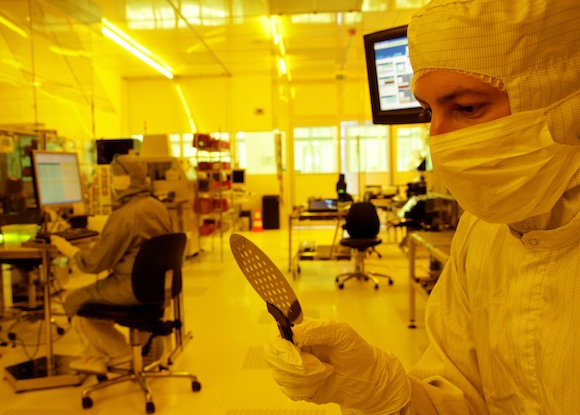A sensor developed by scientists at SINTEF’s MiNaLab will help to make microphones hypersensitive:
“Think of traditional videoconference equipment. Several people are sitting around the table, but the microphone has been placed where its sound reception is less than optimal.
With technology of this sort, a microphone will be able to “see” where the sound comes from, pick up the voice of the person speaking, and filter out other sources of noise in the room,” explains ICT researcher Matthieu Lacolle, who emphasises that acoustics scientists at SINTEF have also contributed to this innovative solution.
Small but tightly packed
The microphone is packed full of microelectronics. What makes it really special, however, is an optical position sensor that is no more than a millimetre in diameter.

The reason for giving a position sensor such an important role is that a microphone is completely dependent on a membrane, which picks up the pressure waves produced by the sound.
“In principle, a microphone acts like a drum. You have a membrane that vibrates when it is impacted by a sound – which is just a series of pressure waves. And then you have a reference surface in the background. The distance between these two surfaces registers the sound. We do this by measuring light waves from a microscopically small laser, so we can say that the sensor in microphones actually sees the sound,” explains Lacolle.
The sensor can measure incredibly small movements, and thus also extremely quiet sounds. If we make the membrane light enough, and let it oscillate freely in the air, the microphone also becomes directionally sensitive. “That also tells us where the sound is coming from,” says Lacolle, adding that the membrane is only 100 nanometres thick, almost 1000 times thinner than a human hair.
Coloured by light
The technology that makes the microphone so sensitive is based on a combination of two optical phenomena; interference and diffraction, both of which are due to the wave character of light.
“If we hold up a CD to the light, we see the play of colours where it reflects the light. This happens because light consists of a spectrum of wavelengths that the naked eye perceives as colours, and these wavelengths are diffracted in different directions, explains Lacolle.
Another phenomenon that can be utilised to measure sound is interference, which occurs when a number of waves are superimposed on each other. You can observe this when you stand in a harbour where incoming waves are reflected by a pier and are superimposed on top of the waves that follow them into the harbour. Complex, apparently chaotic wave patterns can occur, but so do standing waves, which don’t appear to move at all,” says the SINTEF researcher.
What the SINTEF scientists did was to exploit optical diffraction and interference to measure membrane movements of less than the diameter of an atom by using the optimal sensor.
We have created very special grooved microstructures on the reference surface, which lies directly underneath the microphone membrane. When the laser illuminates these microstructures, we can read off the direction in which the light is reflected by means of photodetectors, which transform the light into electrical signals.”
Laboratory mass-production
The microphone thus consists of several elements: an ultrathin membrane, tiny grooved microstructures, a miniaturised laser and a number of photodetectors. Everything is integrated into a tiny circuit that is mass-produced on a silicon wafer on which all the structures are etched, using special equipment within a clean room.
Dust-free production
In MiNaLab’s clean room, production takes place in a highly controlled environment. The production process is extremely sensitive; even a tiny grain of dust can destroy a whole production series, because it can affect the tiny microstructures.
“That’s why our laboratory is equipped with vibration damping and air filters that take out particles as small as 100 nanometres,” explains Lacolle.
Noise monitoring
The Norwegian company Norsonic supplies various types of noise-measurement equipment, and intends to use the new microphone to measure both sound pressure and acoustic power.
“The microphone is the very heart of the equipment that we supply. What is unique about this technology is that it can give us an extremely sensitive microphone that is capable of registering sound waves far beyond the range that microphones in this price class can do today. This lets us compete in a market that is currently occupied by very expensive equipment. Our version is also much smaller, which is an advantage in itself, because the physical size of the microphone actually affects the sound field that it is measuring,” says senior scientist Ole Herman Bjor in Norsonic.
Fact box: How the microphone works
In simple terms, we can say that the new microphone operates as follows:
• First, sound pressure is transformed into movements of the membrane.
• These movements are read optically via the light-sensitive detector.
• The light intensity is measured by a sensor which in turn transforms it into an electronic signal that is capable of reproducing the sound.
Other potential applications for the sensor include:
• geophones for seismic shooting
• photoacoustic gas sensors
• accelerometers
• vibration sensors
• gyroscopes
• pressure sensors
• high-temperature versions of the above-mentioned sensors
• sensors for highly irradiated sites (nuclear power stations, x-ray equipment) or with electromagnetic radiation (sensors in motors or magnetic resonance equipment).
Via SINTEF











